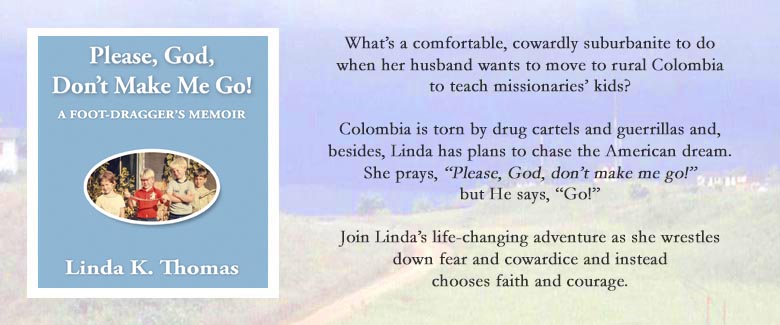Looking back now, I feel overwhelming gratitude for the
people who helped my family and me settle in Lomalinda—people like David Hockett, our neighbor Ruth, Karen Mac, and Lois Metzger. And today I’m going to
tell you about Linda Lackey.
Each person gently oriented me, offered valuable and
practical how-to information, and modeled for me how to live in that foreign
place.
My days and duties were getting less unfamiliar. Chaos was
calming down (emotional, mental, spiritual, and literal) and my homemaking
efforts were slowly making a big difference. Each day my young family and I
were making progress.
But then. . . . But then. . . Rufina began working for us.
Dear Rufina.
There was nothing wrong with Rufina. But there was something
wrong with me.
You see, a Lomalinda lady named Dorothy had
arranged for a pleasant older woman, Rufina, to work at our house one day a
week.
I’d never imagined a person like me would
have a maid, but in Lomalinda it was the thing to do for several reasons.
First, local people needed jobs and, second,
because of the intense heat, we all worked at a slower pace than we did in
cooler regions of the northern hemisphere—it was a health issue—and that meant
we had a hard time getting household chores done.
Third, having a maid freed mothers, like me,
to fill jobs that contributed to the task of Bible translation, the reason we
all lived there.
And fourth, it cost little to hire a maid.
A few years earlier, Rufina’s husband,
a church pastor, had been gunned down by someone waiting for him to step off a
bus. She’d worked for several other Lomalinda families and had never stolen
from them, which was not the case with some maids.
And so, a week before school began, at
seven o’clock on a Tuesday morning, Rufina arrived at our door. She stood only
two inches taller than our first-grader, Matt. (See photo, below.)
Dorothy had given me a mimeographed
sheet in Spanish listing common household chores—Rufina spoke no English—and I
had made a list and rehearsed it several times. When she arrived, I read her my
instructions and let out a big sigh—I was finished! I turned to go—but she had questions.
I hadn’t anticipated that.
I couldn’t make sense of anything she
said so I took a deep breath and told her I didn’t understand. “Yo no
comprendo.” Then I asked her to say it again. “Repite usted, por favor.”
She did, but she talked twice as fast
and twice as long. She was a soft-spoken, gentle lady with a sweet smile that
lit up her face, but that didn’t help me understand her. I hoped to catch a few
words and look them up in my Spanish dictionary, but I didn’t understand even
one.
She
waited for my answer. I trembled. What was I to do? I felt a panic coming over
me. I fought tears.
But
then I remembered—oh, yes, then I remembered!—that on another day of the week,
Rufina worked for the Lackey family. God did that for me—He helped me remember
how I could find practical help.
I
looked up the Lackeys’ number and dialed.
Linda
Lackey answered. Struggling to steady my voice, I asked if she would talk to
Rufina and help me figure out what she was saying.
“Oh,
of course.” Linda spoke so kindly. “Rufina is hard to understand because she’s
missing so many teeth.”
I handed the phone to Rufina, and,
after a long conversation with Linda, she handed it back to me, smiling.
Linda, bless her heart, had helped
Rufina understand me
and helped me understand Rufina.
A huge relief washed over me as Rufina
turned and got to work.
Local maids believed it was bad luck
to finish the day’s work by doing anything other than ironing so, late that
afternoon, Rufina ironed the laundry she had washed that morning. She did an
exquisite job. She even ironed things I would never have ironed myself. And best
of all, she sang while she worked. That in itself was a lovely blessing.
Dorothy had told me to pay Rufina at
the end of each day, putting her pesos in an envelope, and to have her sign a
notebook in which I recorded the date and amount I paid her. She wrote slowly,
the letters large and childlike. It struck me that she probably couldn’t read
or write anything more than her own name.
The memory of that day still stands
out. I hadn’t recognized anything Rufina said after the call to Linda Lackey.
Each time I had asked her to repeat
herself, she did the same thing she’d done in the morning, telling a story
twice as long and twice as fast, with lots of hand gestures and arm-waving. I
lost track of how many times I snuck into my bedroom to dry my tears.
After Rufina left the phone rang, and
Linda Lackey asked how Rufina did the rest of the day.
By then I was a big bundle of nerves—
I’d never had a stranger in my house all
day
—in my home, my refuge—a stranger!
And I burst out sobbing.
I apologized,
but Linda interrupted with comforting
words
and a promise to pray for me.
Afterward, I felt like a big baby. I
reminded myself that Rufina was a lovely lady—sweet, hard-working, and always
smiling.
Rufina didn’t do anything to make you
cry, I told myself. You simply need time to get accustomed to her.
Nevertheless, I was giddy with relief
because I had an entire week to pull
myself together
before she returned.
(From Chapter 10, Please, God, Don’t
Make Me Go:








